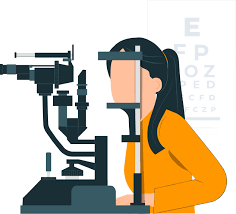A comprehensive eye exam looks at more than just your ability to read letters on a chart. The goal is to assess your vision and overall eye health. Your provider will use several tests to detect any early signs of eye conditions. Knowing what happens during the exam can help you feel more comfortable and prepared.
Your visit often starts with questions about your general health and vision history. Your provider may ask if you’ve had any recent vision problems. They might also ask if your family has a history of conditions like glaucoma or macular degeneration. Some medications and illnesses can affect your eyes, so those details matter as well.
Testing Eye Movement and Pupil Reactions
Your provider will check how your eyes move and respond to light. They may shine a light in your eyes to watch your pupils. This checks for possible nerve problems and how your eyes react to brightness. Then, they’ll test your eye movement by asking you to follow an object with your eyes.
Eye movement tests show how well your eye muscles work together. Poor coordination may lead to double vision or eye strain. These tests also help identify any issues with alignment or tracking. Quick and smooth movement is a good sign of healthy eye function.
Checking Eye Pressure and Internal Structures
The next part of the eye exam involves measuring the pressure inside your eyes. This is called tonometry. It helps screen for glaucoma, a condition that can damage your optic nerve. The test is quick and may involve a puff of air or a light touch with a tool.
Your provider will also examine the front of your eye using a slit-lamp microscope. This tool gives a clear view of structures like the cornea, lens, and iris. They will look for signs of infection, cataracts, or injury. A healthy front eye is clear and smooth, without cloudiness or damage.
Looking at the Retina and Optic Nerve
To get a detailed view of the back of your eye, your provider may use special drops to dilate your pupils. Once the pupils widen, they can better see the retina, optic nerve, and blood vessels. This part of the exam can reveal signs of diabetes, macular degeneration, or high blood pressure.
They may use an ophthalmoscope or other imaging tools. In some cases, they will recommend more testing. These might include high-resolution scans, color vision checks, or corneal mapping. These tools help confirm or rule out possible problems.
Schedule Your Eye Exam Today
Your eyes deserve the same care and attention as the rest of your health. Many common eye conditions, including glaucoma and macular degeneration, begin without noticeable symptoms. A regular eye exam is one of the best ways to detect problems early before they impact your daily life. Even if your vision seems fine, exams can reveal subtle changes and ensure your prescription stays up to date. Don’t wait for warning signs, schedule your eye exam today and take a simple step toward lifelong healthy vision.

